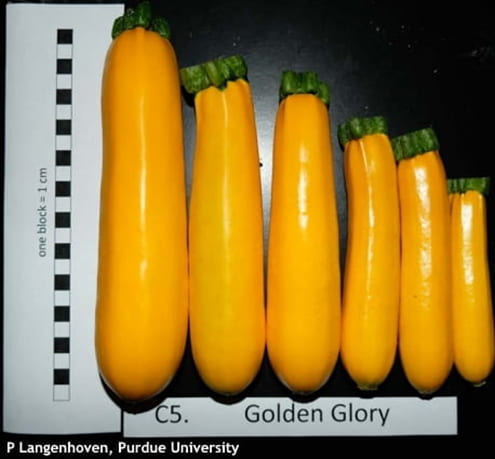Gordon Johnson, Extension Vegetable & Fruit Specialist; gcjohn@udel.edu
Most cucurbit crops including cantaloupes, watermelons, squashes, pumpkins, and cucumbers produce separate male and female flowers (cantaloupes have some perfect flowers). The male flower produces the pollen that must be transferred to the female flower in adequate amounts to set fruit – male flowers must open in synchrony with female flowers and insect pollinators must be active to produce fruits.
Often, fruit set in cucurbits is poor early in the season. In zucchini, yellow squash and other summer squashes, male flowering may be delayed resulting in aborted fruit due to lack of pollen. In contrast, pumpkins that are over-fertilized with nitrogen will see excessive vine growth and delayed female flower formation.
Early in the season some varieties of squash produce a lot of female flowers, which cannot get pollinated until some male flowers appear. Low temperatures and high light intensity promote this female sex expression; female flowers rather than male flowers.
In a Georgia study looking at planting dates over several seasons, the researchers found that pistillate (female) flower counts were more stable than staminate (male) flower counts over a wide range of planting dates for the summer squash cultivars studied. They concluded that that squash staminate and pistillate flower counts fluctuate readily under various field environments.

Aborted yellow squash at the ground level due to no male flowers present.

Yellow squash with male and female flowers in synchrony.
Research has also shown that growth regulators can affect sex expression in squash. In squash plants, male flowers normally form first, while at later stages of reproductive development male and female flowers are initiated in alteration. However, it is well established that treatment with ethylene can cause more female flowers develop when the plants are treated with ethephon (an ethylene releasing agent) and they start to form earlier in development. In contrast, treatment of squash with Gibberellins will increase the number of male flowers and provide for a higher male to female ratio.
In gynoecious pickles, mostly female flowers are produced, thus monoecious pollenizer plants that produce male flowers must be mixed in to produce adequate pollen for fruit set. Seed companies provide cucumber seed blends that contain 85% to 90% gynoecious seed and 10% to 15% monoecious seed. These blends ensure that the optimal proportion of male to female flowers are present in a planting, resulting in good pollination levels and high fruit yields.
In seedless watermelons (triploids), male flowers do not produce viable pollen. Therefore diploid (monecious) pollenizer plants must be planted together with the seedless watermelons to provide adequate pollen for fruit set. Research has shown that a ratio of 3:1 seedless to pollenizer plants provides adequate pollen for good fruit production.
There are many other reasons for poor fruit set in cucurbits, such as inadequate pollinating insects, water stress, heat stress, diseases, and insect damage, however, growers should consider flowering and pollen production as another possible cause for lack of fruit set.
To manage fruit set, choose varieties that more consistently produce male and female flowers under different environments. For early plantings, plantings in high tunnels, or plantings under row covers, consider using parthocarpic varieties if available. Parthenocarpy is the production of fruit without pollination. Some zucchini and cucumber varieties are parthenocarpic or may exhibit parthenocarpy when male flowers are not present.

Golden Glory yellow zucchini exhibits a high level of parthenocarpy.

Parthenocarpic pickling cucumber. There are several parthenocarpic cucumber varieties and types available for growers.
